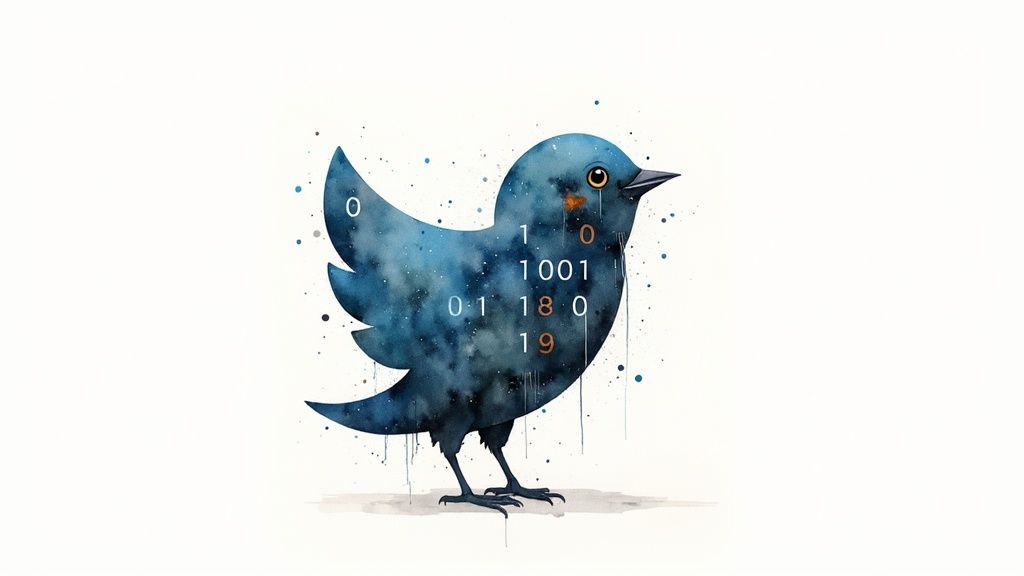




The world of Twitter is increasingly populated by bots, automated accounts designed to mimic human behavior. These bots range from simple scheduled posts sharing news updates to sophisticated entities capable of engaging in complex conversations. This blurring of lines between human and automated interaction has significant implications for how we consume information and engage in online discourse. Why does detecting these digital impostors matter now more than ever?
One key reason is the sheer scale of the problem. Twitter bot detection has become increasingly crucial as the number of these automated accounts continues to grow. A 2023 study estimated that 28 million bot accounts exist on Twitter. This large bot population affects the integrity of social media discourse and poses challenges in detecting and removing malicious bots that spread misinformation.
The detection process often involves sophisticated machine learning models to identify and classify bots. These models rely on datasets that need constant updates to keep pace with evolving bot behaviors. As bots become more sophisticated, developing community-specific detection methods is crucial for accurate bot population estimations within different Twitter communities. More detailed statistics can be found here: OpenReview Forum
The motivations behind bot creation are diverse, ranging from harmless automation to malicious intent. Some bots are designed for legitimate purposes, such as customer service or content scheduling. However, others are created to spread propaganda, manipulate markets, or harass individuals. This spectrum of intent makes it essential to differentiate between beneficial and harmful bot activity.
For example, in the cryptocurrency space, bots can be used to artificially inflate trading volume or spread misleading investment advice. This can lead to significant financial losses for unsuspecting investors. Learn more in this helpful guide: Spotting Crypto Scams on Social Media.
The rise of Twitter bots poses a significant threat to the integrity of online discourse. Bots can be used to amplify certain narratives, suppress dissenting voices, or create the illusion of widespread support for a particular idea. This manipulation can have serious consequences, influencing public opinion and even impacting elections.
Accurately identifying and mitigating the impact of bots is crucial for maintaining a healthy and democratic online environment. The challenge lies in distinguishing between automated accounts and authentic human users, a task that grows increasingly difficult as bots become more advanced. Consequently, the development of robust Twitter bot detection methods is not just a technical challenge, but a societal imperative.

Identifying bots on Twitter has become increasingly challenging. Basic keyword filters and rule-based systems are no longer effective against the increasingly complex nature of automated accounts. This is where the power of machine learning becomes essential. Machine learning algorithms can process vast quantities of Twitter data, learning to differentiate between genuine human behavior and bot-like activity. This capability makes them crucial for combating automated misinformation and platform manipulation.
Twitter bot detection using machine learning models frequently involves several techniques. These models assess a range of behavioral indicators, including:
Posting Cadence: The frequency of an account's tweets. Bots often tweet at a significantly higher rate than humans.
Linguistic Consistencies: The language used in tweets, analyzing vocabulary, sentence structure, and sentiment. Bots may demonstrate repetitive language.
Interaction Networks: An account's interactions, including who they interact with and the nature of those interactions. Bots often have a limited network or mostly engage with other bots.
Engagement Anomalies: Unusual patterns in likes, retweets, and replies. This could include behaviors like excessively retweeting specific content.
These features are derived from raw data using a technique called feature engineering. Feature engineering transforms raw data, such as tweet text and timestamps, into quantifiable metrics that machine learning models can process and analyze. For instance, the frequency with which an account uses certain hashtags can be a valuable indicator for bot detection.
Further enhancing bot detection, machine learning has demonstrably improved the accuracy of identifying bots on Twitter. One study showcased the effectiveness of a combined approach, integrating feature engineering, Natural Language Processing (NLP), and graph-based techniques. This multi-faceted analysis of bot behavior gives researchers a more complete understanding of bot operations and interactions within social media platforms. The application of machine learning algorithms, such as gradient boosting classifiers, has also been explored, notably in areas like health research. Learn More About Hybrid Approaches to Bot Detection
The methods used by Twitter bots are constantly evolving. Bot developers continually devise new strategies to avoid detection. This constant evolution necessitates continuous model training. Regular updates with new data are essential to enable models to recognize emerging bot behaviors and maintain effectiveness. This continuous adaptation is a critical component of the ongoing struggle between bot creators and detection systems.
Several machine learning algorithms are demonstrating high efficacy in Twitter bot detection. These include:
Supervised Learning Models: Trained on labeled datasets of known bots and human users, these models learn to classify accounts based on established patterns.
Neural Networks: These complex models can discern intricate patterns and data relationships, frequently outperforming simpler models.
Ensemble Methods: Combining predictions from multiple models, ensemble methods aim to enhance overall accuracy and robustness.
Each algorithm has its own advantages and disadvantages, and the best choice often depends on the specific application and data available. The models' effectiveness also relies heavily on the quality and representativeness of the training data. Biases within the training data can result in flawed predictions and perpetuate societal biases. Building and maintaining high-quality, diverse datasets is therefore crucial for the development of robust and unbiased bot detection systems. This ongoing effort is vital for protecting the integrity of information shared on platforms like Twitter.
The following table summarizes key machine learning techniques utilized in bot detection on Twitter:
ML Techniques Powering Bot Detection
Comparison of leading machine learning approaches transforming Twitter bot detection, with real-world performance metrics and implementation considerations
| Technique | Detection Features | Typical Accuracy | Strengths | Limitations |
|---|---|---|---|---|
| Supervised Learning (e.g., SVM, Naive Bayes) | Posting frequency, retweet ratio, follower/following ratio | 70-90% | Relatively simple to implement, interpretable results | Can be sensitive to feature engineering, may struggle with evolving bot tactics |
| Neural Networks (e.g., RNN, LSTM) | Content analysis, temporal patterns, network structure | 85-95% | Can capture complex relationships, adaptable to new patterns | Requires large datasets, computationally intensive |
| Ensemble Methods (e.g., Random Forest, Gradient Boosting) | Combination of features from various techniques | 90-98% | High accuracy, robust to noise | Can be difficult to interpret, requires careful tuning |
This table highlights the diverse approaches used in bot detection, each with strengths and limitations. Ensemble methods generally offer the highest accuracy, while neural networks excel at adapting to new bot strategies. Supervised learning methods offer a good balance between performance and interpretability. The continued development of these techniques is paramount to addressing the evolving challenges of bot detection on Twitter.

Even with advanced machine learning techniques, Twitter bot detection remains imperfect. Current systems face inherent limitations, creating vulnerabilities that sophisticated bots can exploit. Understanding these weaknesses is essential for critically evaluating bot detection claims and recognizing the persistent challenges in this ongoing technological arms race.
A significant hurdle is the bias present in training data. Detection models are trained on datasets of known bots and human users. However, these datasets are frequently incomplete or skewed toward specific types of bot activity. This means models might be adept at identifying one type of bot while failing to recognize others, particularly those employing new tactics. This creates blind spots, allowing advanced bots to operate undetected.
For instance, a model trained primarily on spam bots may struggle to identify bots designed for political manipulation. The behavioral patterns differ significantly. Spam bots often post frequently with repetitive content. Political bots, however, might mimic human conversation and engagement. Combating this bias requires diverse and representative training data encompassing the broad spectrum of bot behaviors on Twitter.
Additionally, the accuracy of bot detection models is often inflated. A 2023 MIT study revealed that even complex models perform poorly on unfamiliar datasets, sometimes no better than random chance. This stems from the limitations of data collection and labeling, often performed in narrow contexts that don't generalize well. Explore this further: Study Finds Bot Detection Software Isn't as Accurate as It Seems.
Another key gap lies between laboratory performance and real-world effectiveness. Detection models frequently achieve high accuracy in controlled tests. However, these results rarely translate seamlessly to the dynamic environment of Twitter. Bot creators constantly adapt their strategies to evade detection.
Moreover, the complexity of human behavior on Twitter complicates matters. Defining "bot-like" activity is not always clear-cut. Humans can exhibit behaviors that resemble bots, such as repetitive posting or automated retweets. This can lead to false positives, where real users are misidentified as bots.
Bot creators understand the limitations of detection systems and actively exploit these weaknesses. They develop strategies specifically designed to avoid detection, creating a constant cat-and-mouse game with detection developers.
Camouflage is a common tactic, where bots blend in with genuine users. This might involve mimicking human posting patterns, engaging in natural language conversations, or building realistic follower networks. Polymorphism, where bots continuously change their behavior, is another evasion technique.
The persistent challenge of Twitter bot detection requires constant innovation and adaptation. As bots evolve, detection methods must keep pace. Addressing training data bias, improving real-world performance, and anticipating the evolving tactics of bot creators are crucial steps. This complex technological battle demands a nuanced understanding of both the strengths and limitations of detection systems, along with the motivations and ingenuity of those who create and deploy bots.

Generic Twitter bot detection methods are proving increasingly insufficient. While they offer some protection against basic automated activity, they often miss bots designed for specific purposes within particular fields. This necessitates the development of specialized detection solutions, resulting in significantly improved accuracy and effectiveness.
The diverse nature of bot activity exposes the limitations of generic detection methods. A bot spreading misinformation about healthcare, for example, operates very differently from one manipulating financial markets. Their language, posting patterns, and interaction networks vary considerably. Generic models, trained on broad datasets, often fail to capture these important nuances.
Consider a bot promoting cryptocurrency scams. It might use specific jargon and target particular hashtags. Conversely, a bot spreading political propaganda will likely employ different tactics, focusing on trending topics and engaging in inflammatory discussions. A generic approach simply won't be effective across such diverse scenarios. This is why specialized Twitter bot detection is so crucial.
This need for targeted approaches spans various domains. In healthcare research, for instance, incorporating context-specific features enhances the accuracy of existing systems. Researchers have demonstrated the value of customization by adapting a political bot detection system for health-related tasks. By adding relevant features and using a statistical machine learning classifier, they significantly improved performance. For a deeper dive, read the full research here.
Several domains are already reaping the benefits of specialized Twitter bot detection systems:
Healthcare: These models identify medical misinformation bots by analyzing health-related language, identifying patterns of misinformation, and flagging accounts spreading false claims.
Politics: Political bot detection systems focus on uncovering coordinated manipulation campaigns. They analyze retweet networks, hashtag usage, and account creation dates to detect inauthentic activity and potential foreign interference.
Finance: In the financial sector, these tools detect market manipulation attempts. They monitor trading-related discussions, identify unusual spikes in activity around specific stocks, and flag accounts promoting pump-and-dump schemes.
Developing tailored Twitter bot detection solutions requires careful consideration of several key factors:
Identifying Domain-Relevant Behavioral Patterns: Analyze the specific characteristics of bot activity within your target area. What language do they use? Who do they interact with? What are their typical posting patterns?
Developing Custom Training Datasets: Build training datasets that accurately reflect the real-world challenges within your domain. This requires collecting data on both known bots and genuine users in that specific context.
Evaluating Performance Metrics: Don't rely solely on accuracy. Use a range of relevant metrics, such as precision and recall, to minimize both false positives and false negatives and ensure a truly effective model.
By addressing these considerations, organizations can develop highly accurate Twitter bot detection solutions tailored to their specific requirements. This targeted approach enables them to combat automated threats effectively, protect the integrity of online discussions, and make informed decisions based on reliable Twitter data. This is particularly critical for organizations like Coindive, which caters to crypto investors and enthusiasts. Accurate bot detection is vital for Coindive to filter out market manipulation, allowing users to engage authentically and make sound investment decisions.
Identifying bots on Twitter presents a significant challenge for users and researchers. Fortunately, various tools can help detect these automated accounts, promoting transparency in online discussions. These tools employ different methods, ranging from analyzing posting behavior to examining network connections, to help users understand the accounts they encounter.
Botometer (formerly BotOrNot) is a widely used tool for assessing the likelihood of an account being a bot. It analyzes various aspects of an account's activity, producing a confidence score. This score reflects the probability of automated activity.
While Botometer offers valuable insights, it's important to remember that the score isn't definitive proof of bot activity but an assessment based on observed behavior. Combining Botometer's analysis with other evidence is crucial for forming accurate conclusions.
BotSentinel focuses on identifying and tracking potentially harmful bot networks. It uses a combination of machine learning and human review to monitor accounts and flag suspicious activity.
BotSentinel is particularly effective at identifying coordinated inauthentic behavior, offering valuable insights into the mechanics of bot networks and the spread of misinformation. This is particularly important for understanding how such networks can manipulate public discourse and influence trending topics.
Although no longer active, tweetbotornot, similar to Botometer, utilized algorithms to analyze Twitter accounts. It assigned scores based on several factors, providing insights into potential bot behavior. While a useful tool in its time, understanding the limitations of these tools is paramount, especially when dealing with ever-evolving bot tactics.
To further compare these tools, the following table outlines their core functions and capabilities:
To better understand the tools discussed, let's compare their functionalities in a structured format:
Twitter Bot Detection Arsenal: Tools Compared
Comprehensive analysis of accessible Twitter bot detection tools for various user needs and expertise levels
| Tool Name | Access Type | Key Features | Accuracy Level | Best For |
|---|---|---|---|---|
| Botometer | Public | Confidence score based on account activity analysis | Varies, relies on probabilistic assessment | Individual account analysis |
| BotSentinel | Public | Tracks bot networks, focuses on coordinated inauthentic behavior | Relies on a combination of ML and human analysis | Identifying large-scale bot activity and misinformation campaigns |
| tweetbotornot | Inactive | Algorithmic analysis of Twitter accounts (historical data) | No longer updated, accuracy limited by past data | N/A, serves as a reference for previous bot detection methods |
This table highlights the strengths of each tool, showcasing their diverse approaches to identifying and analyzing bot activity on Twitter. While Botometer offers individual account analysis, BotSentinel excels at uncovering coordinated inauthentic behavior. Though tweetbotornot is no longer functional, its historical data serves as a reminder of the ongoing evolution in bot detection techniques.
Effective bot detection involves a multi-faceted approach. Here are some practical steps:
Using these tools responsibly is vital. Avoid public accusations solely based on bot detection scores, always considering the ethical implications. False accusations can damage reputations and hinder genuine conversations.
For Coindive users, responsible bot detection is crucial for maintaining platform integrity, enabling authentic discussions about cryptocurrency and informed investment decisions. By filtering out fake growth metrics and market manipulation attempts, Coindive empowers users with reliable data and fosters a trustworthy community by preventing the spread of misinformation. This aligns with Coindive's commitment to provide a clear and dependable view of the crypto world, fostering transparency and trust among its users.
The battle against Twitter bots is a constant struggle. As detection methods evolve, so too do the tactics of bot creators. Staying ahead requires continuous innovation in Twitter bot detection techniques.
Traditional bot detection methods often focus on isolated aspects of an account, such as posting frequency or content. Emerging multimodal systems, however, analyze a wider range of data points concurrently. These systems consider text, images, behavioral patterns, and network connections to build a comprehensive profile. For instance, a multimodal system might identify an account posting frequently and sharing low-quality, reposted images. This holistic approach leads to greater accuracy than analyzing these factors individually.
Advanced NLP goes beyond simple keyword analysis. These systems detect subtle linguistic inconsistencies that often evade older detection models. They can identify unusual vocabulary, unnatural sentence structure, and inconsistencies in writing style across multiple accounts potentially controlled by the same source. Several AI Chatbots are being used today on social media platforms. More information about this topic can be found at Chat GPT AI Chatbot. This ability to recognize subtle linguistic cues significantly improves the detection of sophisticated bots mimicking human language.
Just as individuals have unique fingerprints, online behavior creates distinctive patterns. Behavioral biometrics analyzes how users interact with the platform: scrolling speed, typing patterns, mouse movements, and even active times. These analyses generate unique "fingerprints" differentiating human and automated activity, adding another layer of detection. This means even bots that convincingly imitate human language can be identified through their behavioral patterns.
The future of Twitter bot detection hinges on predicting and countering emerging bot strategies. This includes:
The evolution of bot detection methods will be met with increasingly sophisticated bot creation techniques. Bot creators are likely to focus on camouflage and polymorphic behavior, as well as:
The security community is actively addressing these emerging challenges through research into more resilient detection models, development of new features, and collaboration to share data and best practices. This continuous innovation is crucial for protecting the integrity of online information and maintaining trust on platforms like Twitter.